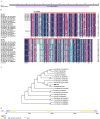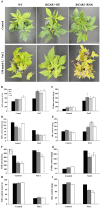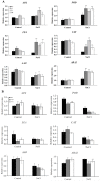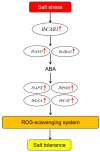A C2-Domain Abscisic Acid-Related Gene, IbCAR1, Positively Enhances Salt Tolerance in Sweet Potato (Ipomoea batatas (L.) Lam.)
- PMID: 36077077
- PMCID: PMC9456122
- DOI: 10.3390/ijms23179680
A C2-Domain Abscisic Acid-Related Gene, IbCAR1, Positively Enhances Salt Tolerance in Sweet Potato (Ipomoea batatas (L.) Lam.)
Abstract
Plant C2-domain abscisic acid-related (CAR) protein family plays an important role in plant growth, abiotic stress responses, and defense regulation. In this study, we cloned the IbCAR1 by homologous cloning method from the transcriptomic data of Xuzishu8, which is a sweet potato cultivar with dark-purple flesh. This gene was expressed in all tissues of sweet potato, with the highest expression level in leaf tissue, and it could be induced by NaCl and ABA. Subcellular localization analyses indicated that IbCAR1 was localized in the nucleus and plasma membrane. The PI staining experiment revealed the distinctive root cell membrane integrity of overexpressed transgenic lines upon salt stress. Salt stress significantly increased the contents of proline, ABA, and the activity of superoxide dismutase (SOD), whereas the content of malondialdehyde (MDA) was decreased in overexpressed lines. On the contrary, RNA interference plants showed sensitivity to salt stress. Overexpression of IbCAR1 in sweet potatoes could improve the salt tolerance of plants, while the RNAi of IbCAR1 significantly increased sensitivity to salt stress in sweet potatoes. Meanwhile, the genes involved in ABA biosynthesis, stress response, and reactive oxygen species (ROS)-scavenging system were upregulated in overexpressed lines under salt stress. Taken together, these results demonstrated that IbCAR1 plays a positive role in salt tolerance by relying on the ABA signal transduction pathway, activating the ROS-scavenging system in sweet potatoes.
Keywords: IbCAR1 gene; abscisic acid; salt stress resistance; sweet potato.
Conflict of interest statement
The authors declare no conflict of interest.
Figures







Similar articles
-
Expression of the Sweet Potato MYB Transcription Factor IbMYB48 Confers Salt and Drought Tolerance in Arabidopsis.Genes (Basel). 2022 Oct 17;13(10):1883. doi: 10.3390/genes13101883. Genes (Basel). 2022. PMID: 36292768 Free PMC article.
-
A Novel WRKY Transcription Factor from Ipomoea trifida, ItfWRKY70, Confers Drought Tolerance in Sweet Potato.Int J Mol Sci. 2022 Jan 8;23(2):686. doi: 10.3390/ijms23020686. Int J Mol Sci. 2022. PMID: 35054868 Free PMC article.
-
A non-tandem CCCH-type zinc-finger protein, IbC3H18, functions as a nuclear transcriptional activator and enhances abiotic stress tolerance in sweet potato.New Phytol. 2019 Sep;223(4):1918-1936. doi: 10.1111/nph.15925. Epub 2019 Jun 26. New Phytol. 2019. PMID: 31091337
-
Research Progress in the Mechanisms of Resistance to Biotic Stress in Sweet Potato.Genes (Basel). 2023 Nov 20;14(11):2106. doi: 10.3390/genes14112106. Genes (Basel). 2023. PMID: 38003049 Free PMC article. Review.
-
Enhancing sweet potato production: a comprehensive analysis of the role of auxins and cytokinins in micropropagation.Planta. 2025 Mar 4;261(4):74. doi: 10.1007/s00425-025-04650-z. Planta. 2025. PMID: 40035890 Free PMC article. Review.
Cited by
-
A comprehensive overview of omics-based approaches to enhance biotic and abiotic stress tolerance in sweet potato.Hortic Res. 2024 Jan 12;11(3):uhae014. doi: 10.1093/hr/uhae014. eCollection 2024 Mar. Hortic Res. 2024. PMID: 38464477 Free PMC article.
-
Genome-Wide Characterization of Soybean 1-Aminocyclopropane-1-carboxylic Acid Synthase Genes Demonstrates the Importance of GmACS15 in the Salt Stress Responses.Int J Mol Sci. 2025 Mar 12;26(6):2526. doi: 10.3390/ijms26062526. Int J Mol Sci. 2025. PMID: 40141168 Free PMC article.
-
Genome-wide identification of the C2-domain abscisic acid-related (CAR) protein family in Rosaceae and functional characterization of PbrCAR1 in pear pollen tube growth.Planta. 2025 Jul 15;262(3):55. doi: 10.1007/s00425-025-04764-4. Planta. 2025. PMID: 40663236
-
Identification and functional characterization of a flavonol synthase gene from sweet potato [Ipomoea batatas (L.) Lam.].Front Plant Sci. 2023 May 10;14:1181173. doi: 10.3389/fpls.2023.1181173. eCollection 2023. Front Plant Sci. 2023. PMID: 37235006 Free PMC article.
-
The role of gibberellin synthase gene VvGA2ox7 acts as a positive regulator to salt stress in Arabidopsis thaliana.BMC Plant Biol. 2024 Nov 7;24(1):1051. doi: 10.1186/s12870-024-05708-y. BMC Plant Biol. 2024. PMID: 39506686 Free PMC article.
References
-
- Yang Y.L., Zhang X.J., Zou H.D., Chen J.Y., Wang Z.Y., Luo Z.X., Yao Z.F., Fang B.P., Huang L.F. Exploration of molecular mechanism of intraspecific cross-incompatibility in sweetpotato by transcriptome and metabolome analysis. Plant Mol. Biol. 2022;109:115–133. doi: 10.1007/s11103-022-01259-8. - DOI - PMC - PubMed
-
- Liu X.Y., Liu S.F., Zhang J., Wu Y.H., Wu W.Y., Zhang Y., Liu B.L., Tang R.M., He L.H., Li R.Z., et al. Optimization of reference genes for qRT-PCR analysis of microRNA expression under abiotic stress conditions in sweetpotato. Plant Physiol. Biochem. 2020;154:379–386. doi: 10.1016/j.plaphy.2020.06.016. - DOI - PubMed
-
- Kim S.E., Lee C.J., Ji C.Y., Kim H.S., Park S.U., Lim Y.H., Park W.S., Ahn M.J., Bian X., Xie Y., et al. Transgenic sweetpotato plants overexpressing tocopherol cyclase display enhanced alpha-tocopherol content and abiotic stress tolerance. Plant Physiol. Biochem. 2019;144:436–444. doi: 10.1016/j.plaphy.2019.09.046. - DOI - PubMed
MeSH terms
Substances
LinkOut - more resources
Full Text Sources
Research Materials
Miscellaneous

